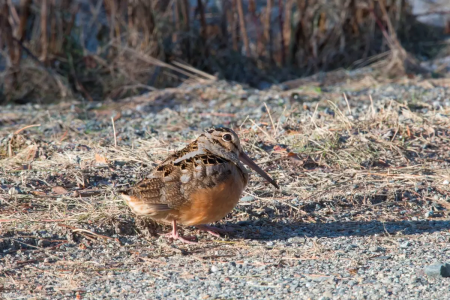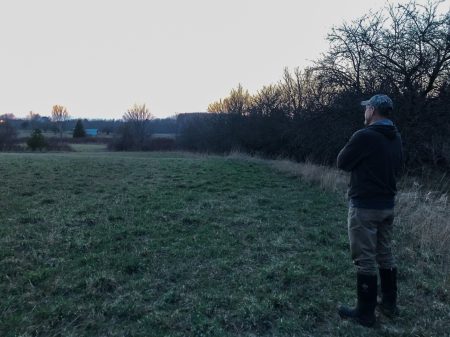There’s this elusive bird found throughout the Great Lakes region. If you know where to look, you can often spot it where fields and wetlands meet. And in spring time, you’ll see it dancing at dawn or dusk.
By Dan Wanschura
The following story is adapted from an episode of Points North, a narrative podcast about the land, water, and inhabitants of the Great Lakes. Listen to more episodes at pointsnorthpodcast.org.
The woodcock is a dull-colored bird just a little bigger than a robin. But don’t let the coloring fool you – this little bird is really cool. That’s because at this rare point of the day, when the light is just right, it does an incredible dance where it shoots up into the sky like a rocket.

I have never been a huge bird guy. Growing up, I was more into toads, frogs and turtles. I had a favorite toad named Burrow and a painted turtle I called Myrtle.
But I remember my uncle taking me out when I was younger to look for snipes, which ironically are very similar to woodcocks. We walked around a small lake in Minnesota with flashlights just after dusk.
It was memorable – but we found nothing – and I was disappointed.
On this night in April, I’m hoping Kieran Fleming and Brian Granger come through. They work with the Little Traverse Conservancy. So far, they’ve delivered on a weird little buzzing noise I’m hearing.

Kieran Fleming at the Elizabeth Hoffman Nature Preserve in Charlevoix, MI, looking and listening for the American woodcock in 2021. (credit: Dan Wanschura / Points North)
“It’s the dumbest sound in the world, isn’t it? It’s just hilarious, it makes me laugh,” said Fleming. “He’s just out there singing his little heart out.”
He’s singing his little heart out trying to attract a mate. The sound he’s making is called ‘peenting.’ And he’s saying something like ‘I’m single and ready to mingle.’
There’s something relaxing about standing in an open field with a microphone at dusk. You start noticing everything around you and it all begins to sound louder. Frogs chirping there – a flock of seagulls passing through – cars roaring by in the distance on U.S. Highway 31.
“He’s (the woodcock) increasing the rapidity of his vocalization,” Granger explained. “That’s an indication he’ll go (up).”
Then all of a sudden, with a frenetic burst of energy, there he is – we finally see him, maybe 100 yards away – the silhouette of a woodcock beating his wings faster and faster in a pastel-colored sky.
“Watch this,” said Granger. “He’ll go up in this big, huge circle.”
A distinct twittering noise comes from air hitting the bird’s feathers as it flies.
“He’s gonna keep going up until we can’t even see him anymore,” describes Kieran.
Up and up the woodcock goes, spiraling hundreds of feet up in the air. And then at the apex of his flight he starts to chirp. That means he’s coming back down. It’s almost like he’s tumbling down in a sort of controlled free fall.
“He’s coming down, he’s coming down, he’s coming down,” Granger exclaimed in a whisper. “Straight that way,” said Fleming, pointing to where the bird lands.
The whole routine is amazing to watch and listen to. I feel as if I’ve peaked behind the curtain of one of nature’s theaters. But now I’m feeling greedy. Can we get even closer?
“I think what we should do is when he gets back up, if you’re game for it, we’ll cut straight across the field right into the bush, right next to that field,” Fleming suggested.
Because the woodcock lands so close to where he takes off, it can be pretty easy to get close to the bird if you’re sneaky. So, when it takes flight for another sky dance, we make our move across the field.
“Ok, let’s go,” said Fleming.
The woodcock population has been declining for decades. Habitat loss is the main reason as there are fewer young forests and wetlands. Fleming calls the bird an indicator species – a sort of thermometer that tells you how the habitat is changing.
“Because it migrates, you know it has to have a habitat Up North for it’s mating season and brewdering, and then it has to have a winter habitat too, and it has to have places to stop off in between,” he explained. “So you know, it’s all connected.”

An American woodcock blends into its surroundings. (credit: Keith Ramos / USFWS)
By now, our woodcock has landed again. And this time we’re just about five yards away, hiding in some brush – grown adults kneeling in soggy ground like we’re kids playing a game of hide and seek.
In his book A Sand County Almanac conservationist Aldo Leopold dedicates an entire essay to the woodcock, titled Sky Dance.
He wrote, “I owned my farm for two years before learning that the sky dance is to be seen over my woods every evening in April and May. Since we discovered it, my family and I have been reluctant to miss even a single performance.”
After this evening, I think I understand why.
A few months after this episode originally aired in 2021, Brian Granger passed away at age 63. This episode is dedicated to his memory.
Dan Wanschura is an award-winning reporter and storyteller based in northern Michigan. He is the host and executive director of Points North, a podcast about the land, water, and inhabitants of the Great Lakes. Some of his favorite stories include meeting a world-class pipe-maker living in the Upper Peninsula, learning the meaning behind the phrase, ‘Thin As A Rail,’ and recounting a harrowing ice fishing trip that nearly turned deadly. Dan lives near the shores of Lake Michigan with his wife and son.






